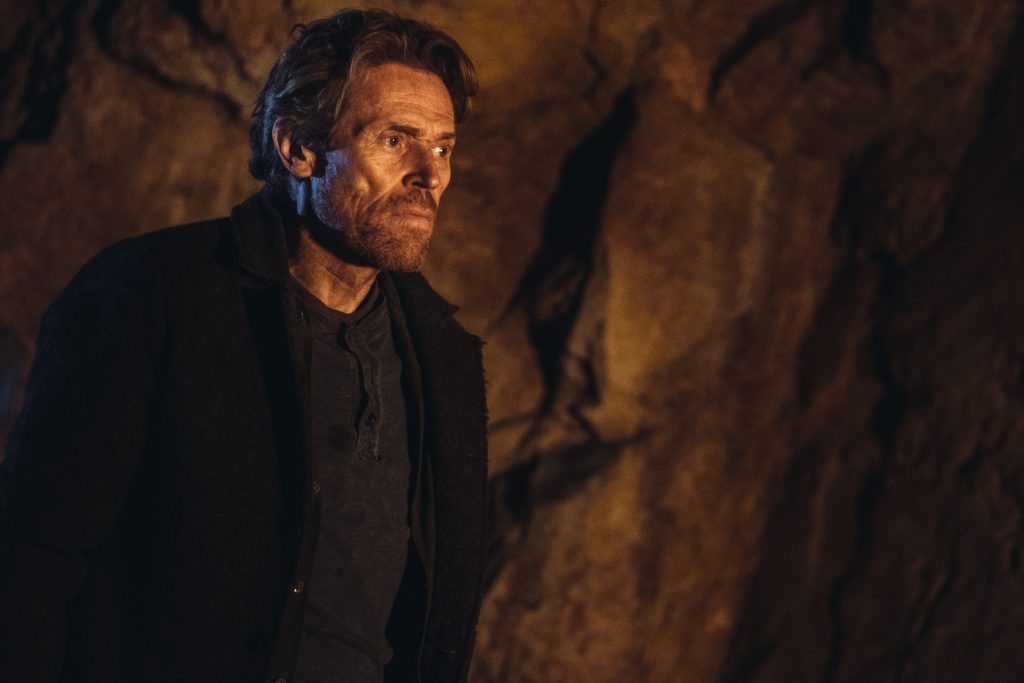December 5, 2021
by Carla Hay

Directed by Abel Ferrara
Culture Representation: Taking place in Rome in 2020, the dramatic film “Zeros and Ones” has a predominantly white cast of characters (with some Asians) representing the working-class and middle-class.
Culture Clash: A middle-aged American soldier goes looking for his missing identical twin brother, who is suspected of being linked to terrorists planning to blow up the Vatican.
Culture Audience: “Zeros and Ones” will appeal primarily to people who are fans of writer/director Abel Ferrara and shallow, sloppily made movies that try to come across as deep and artsy.

The dull and incoherent drama “Zeros and Ones” is an example of how writer/director Abel Ferrara continues to bury himself so self-indulgently in his garbage films that he dumps out, he no longer seems capable of detecting his own cinematic stink. It’s yet another odious entry in Ferrara’s overrated filmography, which is littered with too many half-baked ideas that he’s fooled people into financing, just because he made some provocative films in the 1980s and 1990s. And yet, just like a cult following, there are certain people who think Ferrara can do no wrong. They praise everything he does, even though they would trash his movies if he were an unknown filmmaker.
It’s that same brainwashed mindset that seems to have lured Ethan Hawke into wanting to star in “Zeros and Ones,” which has two separate pre-recorded messages from Hawke: One message is at the beginning of the movie, while the other is at the end. In the introductory message, Hawke says he always wanted to do a movie with Ferrara, but he admits that even he couldn’t tell what “Zeros and Ones” was about when Ferrara sent the movie’s outline to Hawke.
Hawke also says that he didn’t even get a real screenplay, thereby hinting that much of this movie had no real story structure while filming, and people just “winged it” as they went along. It certainly looks that way, because all you’ll see in the time-wasting 86 minutes of total running time for “Zeros and Ones” are a bunch of randomly strewn, mostly darkly lit, shaky-cam scenes that don’t add up to much. You’d be hard-pressed to remember one major plot development in this sloppy and horrendous film.
In the movie’s end-credits message, Hawke almost looks a little embarrassed that he was somehow convinced to do a shill campaign video message to try to explain why this crappy movie even exists. It’s bad enough that Hawke is starring in this forgettable mess. It looks like Ferrara or someone on the filmmaking team coaxed Hawke to also be a movie publicist in these messages, where he somewhat pathetically pleads viewers to try to understand what the film is about. In the end-credits message, Hawke doesn’t even really want to talk about “Zeros and Ones,” but instead gives a rambling monologue about how life can be looked at optimistically or pessimistically. Maybe that’s his way of making himself feel better that he got caught in another stinker bomb from Ferrara.
“Zeros and Ones” is supposed to be about an American soldier named J.J. Jericho (played by Hawke), who goes to Rome to find his identical twin brother Justin Jericho (also played by Hawke), who has gone missing. At various points in the movie, people tell J.J. that Justin is imprisoned or is dead. It’s easy to tell these twin characters apart. Justin is the one who looks like he was rejected for an audition to play Charles Manson.
Why is Justin in trouble? He’s a suspected terrorist. And the word is that he knows about plans to blow up the Vatican. This movie takes place in 2020, during the COVID-19 pandemic quarantines, so there are several references to the pandemic during the movie. It looks like many of the outdoor scenes were filmed in a rushed and jittery manner, as if maybe the filmmakers didn’t have a permit and wanted to get the filming done before they could get caught.
“Zeros and Ones” is such a pointless movie, Ferrara has problems explaining what the movie is about in his incoherent director’s statement that was supplied to the media. He comments in the statement: “‘Zeros and Ones’ is a film of lockdown and war, danger and espionage, American soldiers, Chinese middlemen, Middle Eastern holy men, provocateurs, diplomats, rogue elements of the KGB, and the Mossad, informants, killers and rebels. Male or female interchangeable, allegiance and history fluid, where data and information last known, is the most valuable and only commodity.”
The rambling statement continues: “A casbahesque landscape of noir streets, the feeling of Paris at the end of the occupation—but set in today’s post-modern, ancient and unchangeable Rome—the nights deserted except for the shadowy military and their operatives, paranoia and fear both masked and dangerous—all awaiting imminent attack. Piazza Vittorio, ground zero for our film. J. Jericho its hero. An American soldier armed with a video camera, service revolver and a surgical mask, he is of rank and privilege and deep within the inner circle of elite fellow officers who are the law among the lawless, their contacts and their informers.”
More ramblings in the statement: “The central event is the destruction of the Vatican which will be blown into the night sky—the truth of this—and the fake news surrounding exactly who is responsible and why—is only part of the story. More important is JJ’s own brother—the radical, the wanted revolutionary, the martyr, savior and public enemy accused of pushing our world towards a final confrontation, one that will force all the players to finally choose a side then take a stand.”
That last sentence in the statement actually doesn’t happen to the movie. Instead, what you see are random scenes haphazardly edited together, if you can actually see what’s happening because almost everything in this movie is so murky and ugly-looking. There’s J.J. being driven around in a Jeep, where he’s dropped off at various locations and takes a video camera with him. J.J. eventually encounters a shady character named Luciano (played by Valerio Mastandrea), who does a lot of standing around and scowling.
And there’s J.J. going to the home of a woman named Valeria (played by Valeria Correale), who kisses J.J. on the mouth while they’re both wearing their pandemic masks. She asks him, “Have you figured out what you’re doing in my country?” J.J. replies, “I’m working on it,” which is the sort of confusion that Hawke must’ve felt as he asked himself while filming: “Have I figured out what I’m doing in this train-wreck movie?”
There’s J.J. buying cocaine from a mysterious woman named Jiao (played by Korlan Madi), in what might be a massage parlor. J.J. has bought the cocaine so that he can use it to later bribe someone for information. Jiao appears to be not only a drug dealer but also some kind of madam, because there are two scantily clad women nearby who are making out with each other. The women are identified in the film’s end credits as Jiao’s Girl #1 (played by Barbara Andres) and Jiao’s Girl #2 (played by Sun Jiaying), who normally would be forgotten background extras, except that they show up later in the film because Ferrara can’t seem to make a movie without showing exploitative misogyny.
That’s because Jiao and her two “girls” are later seen in a lingering close-up scene as bloody, mutilated corpses in “Zeros and Ones,” with no explanation. It’s seems that Ferrara can’t get enough of showing women as targets of bloody violence in his most recent films. It’s a disgusting fixation that his gullible “fans” want to ignore, or maybe they condone it. It’s all just lazy filmmaking that shows Ferrara is so creatively bankrupt that he repeatedly puts in his movies the misogynistic trope of women being killed in excessively violent ways.
Ferrara has also been putting his much-younger wife Cristina Chiriac in his most recent movies, because apparently that’s the only way she can get work as an actress, based on her filmography. (As of this writing, the only acting credits that Chiriac has are in movies that have been directed by Ferrara.) In “Zeros and Ones,” Chiriac plays one of two unnamed female Russian agents (Chiriac is brunette, the other actress is blonde), who are first seen randomly having a dinner with some men where they all ramble on about Norman Mailer. This dinner conversation has nothing to do with the movie’s so-called plot.
Later, the blonde female Russian agent (played by Dounia Sichov), who is sullen and tries to look tough, holds up a gun to J.J., and forces him into a bedroom where a man identified as a doctor (played by Simone Gandolfo) also has a gun and is standing near a video camera that is recording what’s about to happen. The female Russian agent played by Chiriac is on the bed wearing lingerie and trying to look seductive.
The blonde Russian agent then barks to J.J.: “Here’s the deal. You knock her up, and you walk out of here.” The armed agent also tells J.J. that the doctor is standing by with the necessary medical equipment to find out if the sex has resulted in a pregnancy. And so, J.J. is held hostage at gunpoint to have sex with the brunette female Russian agent, who is depicted by the real-life wife of the director.
Why is J.J. being forced to impregnate her? Don’t expect an explanation. This sex scene isn’t explicit, but the fact that Ferrara put what is essentially a sexual-assault scene (any non-consensual sex is sexual assault) in the movie tells people more than we need to know about why he wanted his wife to do this type of twisted sex scene.
As for J.J.’s suspected terrorist twin Justin, he’s being held captive somewhere in a grungy-looking torture room. Justin is dirty-looking, disheveled and unhinged. He doesn’t look capable of remembering his name, let alone masterminding a plot to blow up the Vatican. Justin’s captors are men with Middle Eastern accents (more lazy stereotyping), and he’s injected with an unnamed drug.
Before whatever Justin was injected with starts to take effect, he shouts: “It takes more than guns to kill a man! You can’t kill me! I’ll be back after the sound and fury is finished!” Later, Justin yells repeatedly, “How come no one is lighting themselves on fire anymore?”
In another part of the movie, an unidentified man goes through water torture. Watching “Zeros and Ones” is a different type of torture. Don’t expect the movie’s title to be explained. But here’s what the title of the movie should be about: The “zeros” are the loser characters in this movie, and the “ones” are the unlucky individuals who got suckered into funding this trash dump passing itself off as a movie.
Lionsgate released “Zeros and Ones” in select U.S. cinemas, digital and VOD on November 14, 2021. The movie’s release date on Blu-ray and DVD is January 4, 2022.




